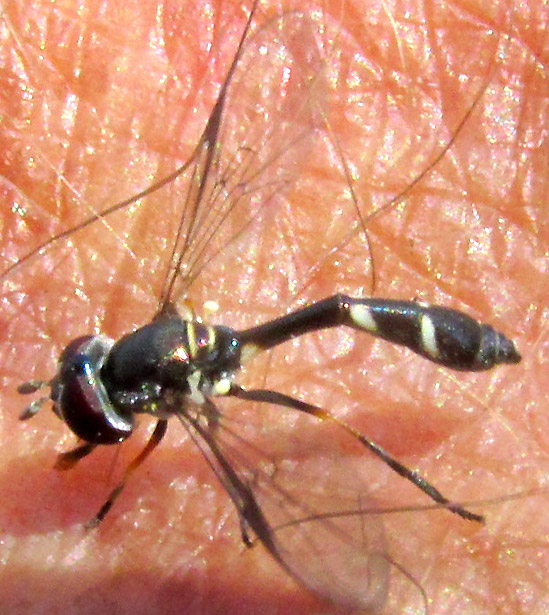Excerpts from Jim Conrad's
Naturalist Newsletter
Entry dated March 8, 2024, from notes taken about 2kms south of Higuerillas, Municipality of Cadereyta de Montes; N20.8872°, W99.7718°, elevation ~1660 meters (~5450 feet); on alluvium of valley floor; local narrow belt of vegetation constituting an extreme southern extension of the Chihuahuan Desert, Meridional Subregion; central Querétaro state, MÉXICO
FOUR-SPECKLED HOVER FLY

When it's hot, it's normal for insects to land on exposed body parts and sop up salt-containing sweat. Here in the hot southern extension of the Chihuahuan Desert my sweat evaporated so quickly that I felt dry, but somehow the above sweat-sopper knew my arm was producing sweat, leaving invisible salt on my skin, and he wanted it.
With its narrow waist and the white bands on its abdomen, at first it looked like a wasp. However, wasps as well as bees bear four wings, while the above individual has only two. Usually the antennae of wasps are longer and more slender, and without such an egg-shaped tip as seen above. Our sweat sopper was a fly, not a wasp.
Moreover, this fly's behavior -- its apparent lack of fear and its continuing focus on steady sopping -- it's big, eye-covered head, and those short, bulbous-tipped antennae, all reminded me of various hoverflies encountered wherever I've gone. For example, there were the Thick-legged Hoverfly in the mountains of Oregon, and Green Hover Flies in the Yucatan. Therefore, I strongly suspected that here was another member of the Hoverfly Family, the Syrphidae.
The Hoverfly Family is a big one, with around 6000 species in about 200 genera described worldwide. Since hoverflies are stingerless and perfectly harmless to humans, many species have evolved to mimic wasps and bees to keep predators away.
In the above picture, just to the right of the base of each wing, notice the small, white, egglike things. Those are halteres, evolved from their distant ancestors' second pair of wings; the first insects possessed four wings, like dragonflies and most insects still do. Halteres help hoverflies keep their balance as they fly, for the basic physics of flying with two flapping wings creates instability. Birds and airplanes have tails for stabilization, but bugs don't.
Frequently I've read that hoverflies are attracted by sweat not only because of its water but also for the salts excreted from our bodies. Animals need salt, and flower nectar and pollen contains little of it. Susan Nicolson's 2022 work "Sweet Solutions: Nectar Chemistry and Quality" reports that bees and hoverflies obtain amino acids from pollen, but she says nothing about salt. Adults of most hoverfly species feed mainly on nectar and pollen, and the larvae eat decaying organic material.
Whatever reason this particular hoverfly sopped dried sweat from my arm, knowing the family it belong to made it easy enough to identify by going to the iNaturalist.Org website and browsing photos of members of the Syrphidae found in Mexico. The images of numerous species were scanned, until one of them showed a hoverfly just like ours. It was DIOPROSOPA CLAVATA, in books often known as the Four-speckled Hoverfly.
Being in such a harsh, isolated part of Mexico, I thought my sweat sopper might be a rare species. However, Dioprosopa clavata commonly occurs throughout most the New World Americas, except the colder parts. Unlike the dead-organic-matter-eating larvae of most hoverfly species, Dioprosopa clavata lays eggs among aphids, and when the eggs hatch the maggot-like immature stage feeds mainly on the aphids. Informed gardeners like Four-speckled Hoverflies not only as pest-control agents, but also because, after bees, hoverflies are the best of all insect pollinators.